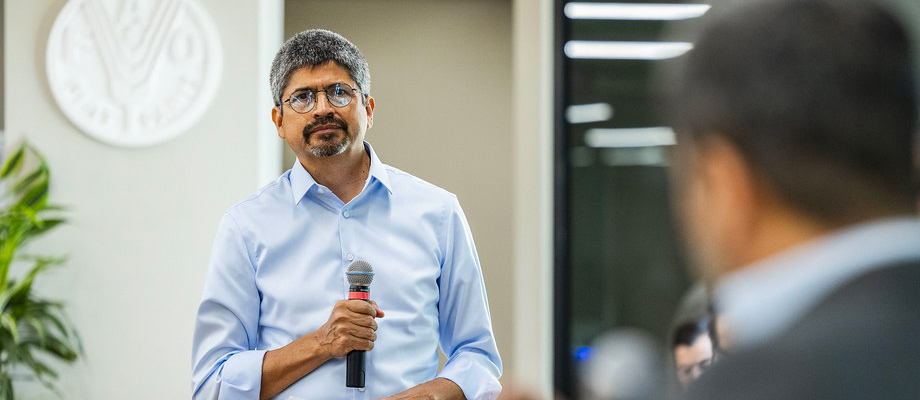A chat with the Investment Centre’s Service Chief for East and Southern Africa

Giovanni Munoz, the Investment Centre's Service Chief for East and Southern Africa, reflects on a long career in the agriculture sector, his vision for the region and why getting out of one's comfort zone is good.
Tell us about yourself.
I grew up in Bogota, Colombia, where I studied agricultural engineering. I've always loved the countryside. Every holiday when I was a child, we would visit my grandmother's farm. I saw how difficult farmers' lives were, but I also became interested in agriculture at a young age. After graduating, I worked for a small irrigation consultancy firm in 1991. Later, I worked in Ukraine on irrigation and water management, and then I got my master's degree in land and water management in the United Kingdom.
When did you first join FAO?
I joined FAO in 2001 as a water development officer in the Land and Water Division, working on projects in Africa, Central Asia and Latin America. In 2006, I volunteered to work at FAO's new Subregional Office for Central Asia in Ankara, Turkey, because I felt it was a great opportunity to be closer to the field. I later joined the Investment Centre in 2011. I always believe that after about five years in the same position, it's good to change, to get out of your comfort zone. So, in 2017, I took a job with the European Investment Bank (EIB) in Luxembourg, first as a senior engineer and then as the Principal Adviser for the Bio-economy Division, where I gained experience in private sector investments and working with financial intermediaries inside and outside the European Union. I re-joined the Investment Centre as Service Chief earlier this year, bringing to the job my experience with FAO as well as the perspective of the Bank.
What do you see as the Centre's biggest strengths?
The fact that we can put together multidisciplinary teams is a huge advantage. It allows us to support investment projects comprehensively and to look at those projects from all angles to ensure they are as impactful as possible. We are diversifying our partnerships, which gives us more options when advising countries on how to have different types of investment projects financed, depending on the strengths of the financing partner. And we are sharing best practices with these financing partners, which opens doors and allows us to bring in more innovative aspects into project design and implementation support.
The Centre's new Transformation Plan, focused on the '4+2' solutions, provide us with a powerful tool to introduce ourselves to partners, clarify who we are and what they can expect from us in terms of expertise. When I first joined the Investment Centre, we had three geographic services. We now have five, which reflects the growing volume of lending and intensity of the work. Project designs today are more complex than they were 15 years ago. The requirements keep growing – not just those related to social aspects like greater inclusion, but also to those related to climate action. By expanding our team and having these dedicated services, we can build the capacity we need to maintain a high level of quality in our delivery.
What is your vision for your region?
One immediate goal is to continue rekindling our partnership with the African Development Bank (AfDB), a process that began before I joined. We are currently working with AfDB to design a new investment project in South Sudan, and we expect to see more such projects in the future. I want to strengthen our collaboration with the International Fund for Agricultural Development so that we can plan our work and allocate our resources more efficiently, not just for project design but also for implementation support. And we've recently signed an agreement with a new financing partner, the EIB. The focus is sub-Saharan Africa, but I believe this first collaboration could lead to future agreements to partner with the EIB in other geographic regions, too.
The East and Southern Africa region has the highest level of food insecurity in the world. We need to find ways to increase the capacity of governments to implement their own agrifood investment projects. I am also seeking opportunities where we can work with countries and our partners to do even more in the region in areas like policy and analytical work, support to private investment and innovative finance.
Describe your management style.
I'm available to my team whenever they need me, and I share the knowledge and information they need to do their jobs in the best possible way. I'm also eager to learn from the other Service Chiefs in how they manage their services and their work with our partners. I see my role as enabling and supporting staff in the service to do their best.
What are your hobbies?
I enjoy reading and cinema in my free time. I also love walking in nature, particularly in forests. It's a passion for me. As I said before, being in nature is one of the reasons I chose the career path I did.
